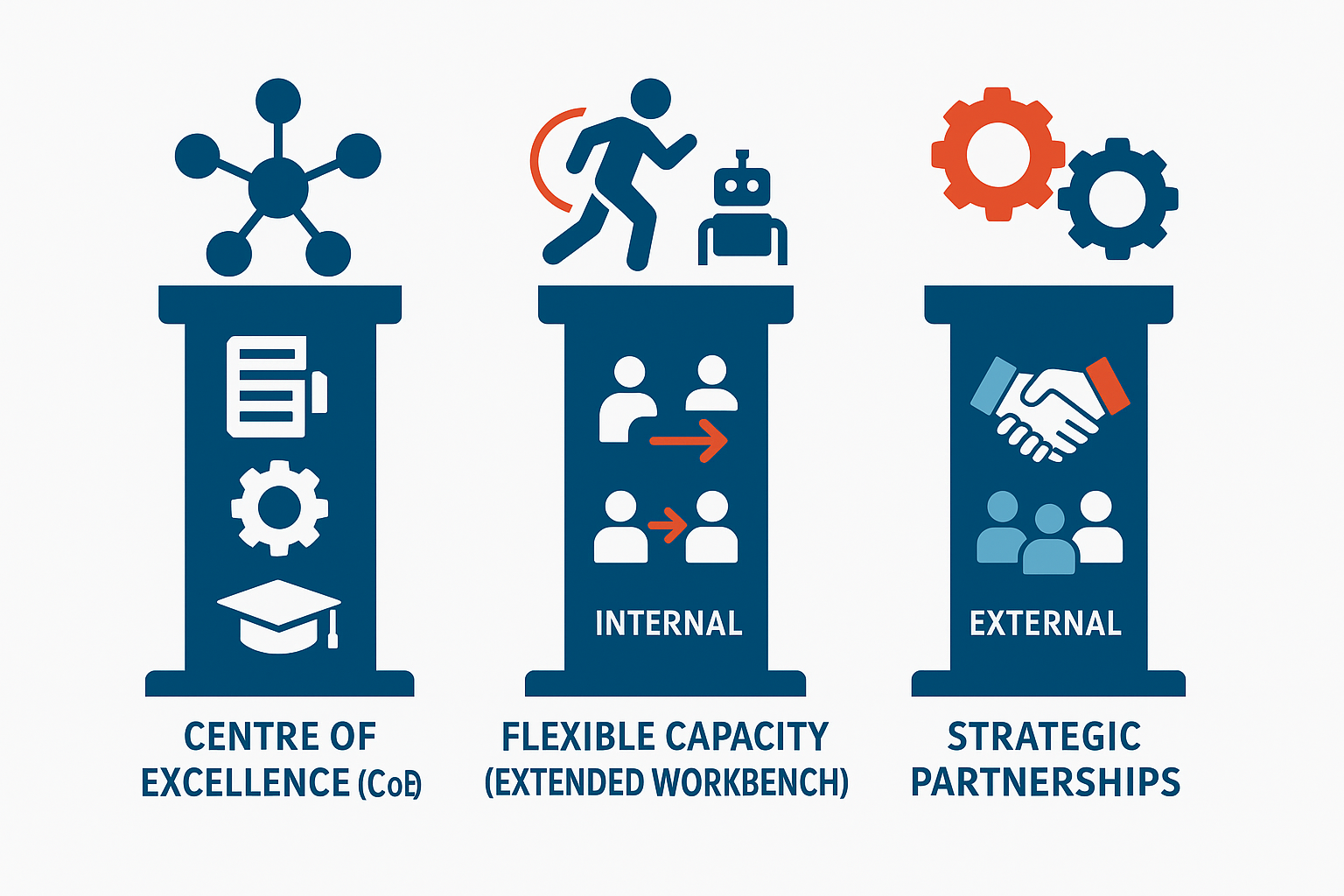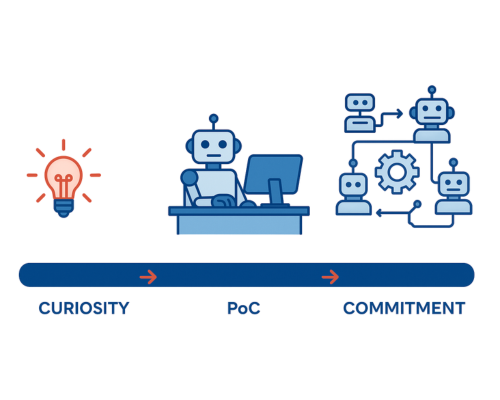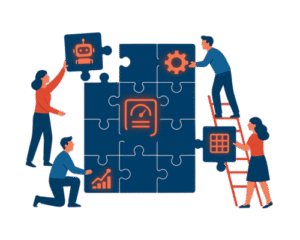Six months ago, a mid-sized insurance company invested $200,000 in their first intelligent automation implementation.
The proof of concept worked beautifully – a claims processing workflow that once took 45 minutes now ran in under 10. The leadership team was thrilled.
Fast forward to today, and that same bot sits idle.
The business analyst who understood the process left. The IT team lacks bandwidth to maintain it. The automation program that began with so much promise has quietly faded into the background.
Sound familiar?
This scenario plays out thousands of times across industries. Research from EY has shown that 30-50% of initial RPA projects fail, while only 3% of organizations successfully scale their automation efforts beyond pilot programs.
The gap between initial curiosity and sustained commitment in enterprise automation implementation isn’t just wide – it’s where most digital transformation initiatives fade.
Understanding the stages of automation implementation and the critical moments where initiatives falter is the difference between another failed pilot and a genuine competitive advantage.
Stage 1: The Exploration Phase
Every successful enterprise automation implementation begins with curiosity.
A CFO reads about AI-powered automation saving millions in operational costs. An operations manager sees a competitor announce their digital workforce. A business analyst attends a webinar and imagines what intelligent automation could mean for their manual work backlog.
What the Exploration Stage Looks Like
- Attending vendor demos and industry conferences
- Downloading whitepapers and ROI calculators
- Building initial business cases
- Evaluating platforms: UiPath vs. Automation Anywhere vs. Power Platform
The language is aspirational: “We’re exploring RPA options,” “We’re building a business case,” “We’re trying to understand the art of the possible.”
This is where drop-off risk increases when enterprises get stuck in the analysis paralysis.
Teams spend 6-9 months evaluating platforms without ever pulling the trigger. Meanwhile, competitors move forward and the cost of manual processes compounds.
How to Bridge This Gap?
Stop asking “Which platform is best?” Start asking “What process pain points can we no longer afford to ignore?”
One healthcare provider reduced their claims processing time by 50% not because they chose the perfect platform first, but because they identified their most broken process and committed to fixing it.
Claims Processing Automation
Max Healthcare, a leading healthcare provider, automated its claims processing with Intelligent Automation to streamline operations and reduce manual effort.
Read Case StudyKey takeaway: Start with the problem, not the technology.
Stage 2: The Proof of Concept
Once exploration turns into action, most enterprises enter the PoC phase. This is where automation becomes real—a specific process, defined scope, and measurable outcomes.
It’s also where the first major chasm opens.
Why PoCs Usually Succeed (But Programs Don’t)
Pilots are designed to succeed:
- High-impact, low-complexity process selection
- Dedicated resources allocated
- Vendor hand-holding throughout
- Controlled test environment
- Clear success metrics
Then reality hits: what happens after the pilot?
According to IDC research undertaken with Lenovo, 88% of AI proof of concepts don’t make it to widescale deployment. For every 33 AI POCs a company launched, only four graduated to production.
The Four Reasons Enterprise Automation Implementation Fails After PoC
- Resource Evaporation
The consultant who built the PoC moves to another project. The business analyst returns to their day job. IT’s attention shifts to the next urgent initiative. - Knowledge Drain
Documentation was minimal because “Sarah knows how it works.” When Sarah leaves, the automation becomes a black box no one can maintain. - Environment Reality
The PoC ran in a sandbox. Production has legacy systems, security protocols, API rate limits, and edge cases no one anticipated during the demo. - Success Theatre
Leadership celebrates a 40% efficiency gain without acknowledging the automated process represents 2% of total operations. Scaling to the remaining 98% requires exponentially more effort.
Where does the drop-off happen?
When companies end up with 10-15 disconnected bots, each solving a narrow problem, none contributing to systemic transformation.
How to Bridge This Gap
Treat automation as a program, not a project.
Before scaling your enterprise automation implementation:
- Establish governance frameworks
- Document every exception and edge case
- Plan for ongoing maintenance and evolution
- Define clear ownership and accountability
- Create knowledge transfer protocols
The bridge here isn’t more technology – it’s operational discipline.
Stage 3: The Scaling Challenge
You’ve proven automation works. You’ve identified 30+ additional processes. Your business case shows millions in potential savings.
So why does your enterprise automation implementation slow to a crawl?
The Hidden Complexity of Scaling
Scaling isn’t linear multiplication of your pilot. It’s a fundamentally different operating model.
Technical Infrastructure Requirements
Pilot Phase | Production Scale |
Desktop-based execution | Enterprise orchestration platform |
Manual version control | Automated CI/CD pipelines |
Test environment only | Dev, test, UAT, production environments |
Basic security | Enterprise-grade security & compliance |
A financial services company discovered their successful pilot couldn’t pass production security reviews, requiring four months of re-architecting before deployment.
The Talent Bottleneck in Enterprise Automation Implementation
A consultant built your pilot. Scaling demands ongoing development capacity.
The challenge:
- In the tech sector, the average employee tenure is around 2-3 years, with software engineers and developers averaging about 2 years
- Average time to hire: 3-4 months
- Market competition: Intense and growing
The result? Your pipeline of automation opportunities grows faster than your delivery capacity.
Process Complexity Escalation
Early wins: Simple, rules-based workflows (invoice processing, data entry)
Next wave: Complex processes with multiple systems, unstructured data, approval chains, exception handling
These require sophisticated solutions – AI, machine learning, intelligent document processing – demanding different skill sets and longer development cycles.
Real-World Scaling Reality
A manufacturing company’s journey:
- Pilot success: Invoice processing saved 200 hours monthly
- Scaling plan: Automate 15 additional finance processes
- Two years later: Only 3 more processes automated
- The bottleneck: Sustainable execution capacity, not budget or technology
The Drop-Off?
Initial momentum dissipates. Quarterly pressures prioritize firefighting over transformation. Automation becomes “something we tried” rather than “how we operate.”
Building for Success: The Three Pillars of Enterprise Automation Implementation
Enterprises that successfully scale automation share a common understanding: implementation isn’t an IT project – it’s an operational capability requiring dedicated infrastructure.

Pillar 1: Establishing a Centre of Excellence (CoE)
A properly structured CoE is the connective tissue between strategic vision and tactical execution.
What an Effective CoE Provides
- Standardization
Consistent development practices, reusable components, architectural patterns that prevent technical debt accumulation.
When every bot is built differently, maintenance becomes impossible at scale.
- Intelligent Prioritization
Transparent evaluation of automation opportunities based on:
- ROI potential and business impact
- Strategic alignment with company goals
- Technical feasibility and complexity
- Resource availability and timing
- Knowledge Management
- Centralized documentation repository
- Training programs and certification paths
- Communities of practice
- Regular knowledge sharing sessions
- Continuous Improvement
- Bot performance monitoring and analytics
- Optimization opportunity identification
- Roadmap evolution based on results
- Lessons learned documentation
Important: A CoE provides the framework, but execution requires capacity.
Pillar 2: Flexible Capacity Model (Extended Workbench)
Traditional hiring creates a predictable pain cycle in enterprise automation implementation:
- Post job requisition
- Wait 3-4 months to hire
- Onboard and train
- Hope they stay beyond 2 years
- Repeat when they leave
The Elastic Capacity Alternative
Instead of building large permanent teams, maintain a lean core supplemented by flexible resources that scale with demand.

How Flexible Capacity Solves Implementation Challenges
Challenge | Traditional Model | Flexible EWB Model |
Speed to execution | 3-4 months | Days to weeks |
Cost structure | Fixed overhead | Variable with demand |
Knowledge risk | Single points of failure | Distributed expertise |
Skill diversity | Limited to hires | Access to specialists |
Scalability | Constrained by headcount | Elastic capacity |
Real Results from Flexible Implementation
Healthcare company case study
- Core team: 3 permanent members
- Flexible pool: 8 rotation resources
- Timeframe: 18 months
- Automations delivered: 47 processes
- vs. Traditional projection: 16 processes
- Performance: 3x projected output
When Flexible Capacity Makes Sense
This model excels when you need:
- Rapid deployment for time-sensitive processes
- Specialized skills (Power Platform, Python, AI integration)
- Variable workload management
- Knowledge distribution and risk mitigation
- Cost optimization during different project phases
Pillar 3: Strategic Implementation Partnerships
Successful enterprise automation implementation requires knowing what to build internally versus source externally.
The extremes to avoid:
❌ Total outsourcing: Build no internal capability, create vendor dependency
❌ Total insularity: Recreate existing solutions, stretch timelines unnecessarily
The Balanced Partnership Approach
Strategic partnerships should transfer knowledge while delivering results.

Questions to Evaluate Implementation Partners
Before engaging, assess:
- Do they document as they build?
Can your team maintain what they create? - Are they solving your problems?
Or selling their standard playbook? - Do timelines include change management?
Not just technical delivery? - Do they provide ongoing support also?
Or is this purely transactional? - Do they have relevant industry experience?
Healthcare, finance, insurance, manufacturing?
Goal: Find partners who help you become better at automation while delivering immediate value.
Stage 4: Achieving Commitment
True commitment is reached when automation transitions from special initiative to “how we work.”
The 5 Markers of Implementation Maturity
- Budget Integration
Automation has dedicated, recurring budget lines—not one-time project funding.
- Process Design Evolution
New processes are designed with automation in mind from the start, not retrofitted later.
- Talent Development
Clear career paths exist for automation professionals with advancement opportunities.

- Outcome-Based Metrics
Success measured by:
- Process cycle time reduction
- Error rate improvement
- Customer satisfaction increases
- Employee engagement scores
Not just: bots deployed or hours saved.
- Cultural Integration
- Automation discussed in all department meetings
- Annual reviews include automation contributions
- Resistance transforms into proactive opportunity identification
Future-Proofing Your Enterprise Automation Implementation
The automation landscape is rapidly evolving. The global RPA market reached $22.80 billion in 2024 and is projected to reach $211.06 billion by 2034, growing at a CAGR of 25.01%. What began as rules-based RPA is expanding into intelligent automation incorporating AI, machine learning, and agentic capabilities.
How to Build for Tomorrow
- Modular Architecture
Can you integrate new AI capabilities without complete rebuilds? - Data Strategy
Are you capturing process data for analysis, optimization, and AI training? - Skill Evolution
Traditional skills: Process mapping, bot building
Future skills: AI training, model refinement, ethical AI governance
- Strategic Patience
Not every new technology requires immediate adoption. Match solutions to your maturity level.
Commitment means continuous evolution, not arrival at a final destination.
Frequently Asked Questions (FAQs)

What is enterprise automation implementation?
Enterprise automation implementation is the structured process of deploying robotic process automation (RPA) and intelligent automation solutions across an organization – from initial pilot through scaled production. It includes technology deployment, governance establishment, talent development, and change management.
Why do most automation implementations fail after the pilot phase?
Most automation implementation fail due to four key factors: resource evaporation after the pilot, knowledge drain when key people leave, underestimating production environment complexity, and lack of sustainable execution capacity for scaling.
How long does successful enterprise automation implementation take?
Initial pilots typically take 6-12 weeks. However, reaching true organizational commitment and scaled implementation typically requires 18-24 months of sustained effort, investment, and leadership support.
What is an automation Centre of Excellence (CoE)?
An automation CoE is a dedicated team providing standardization, governance, prioritization, knowledge management, and continuous improvement for automation programs. It serves as the bridge between strategic vision and tactical execution.
What’s the difference between RPA and intelligent automation?
RPA handles rules-based, structured processes using predetermined logic. Intelligent automation incorporates AI, machine learning, and natural language processing to handle unstructured data, make decisions, and continuously improve.
Should we build automation capabilities in-house or outsource?
The most successful approach is balanced: maintain lean internal core capabilities for strategy and governance, while leveraging flexible external resources for specialized skills and variable capacity needs.
What processes should we automate first?
Prioritize processes that are: high-volume and repetitive, rules-based with clear logic, prone to human error, time-sensitive, and have measurable business impact. Avoid starting with highly complex or exception-heavy processes.
How do we measure enterprise automation implementation success?
Beyond bots deployed and hours saved, measure: process cycle time reduction, error rate improvement, employee satisfaction, customer experience metrics, scalability (automations per quarter), and business outcome impact.
What is an Extended Workbench (EWB) model in automation?
An Extended Workbench is a flexible resource model providing access to pre-vetted automation talent (developers, analysts, architects), having the ability to scale capacity up or down based on implementation needs – without the overhead of permanent hiring.
Conclusion
The gap between curiosity and commitment in enterprise automation implementation isn’t technical – it’s organizational.
The tools work. The ROI is proven. The case studies are compelling.
What separates successful implementations from failed pilots is infrastructure: sustained investment, dedicated teams, and ongoing executive commitment.
Two Paths Forward
Path 1: Perpetual Piloting
Launching isolated PoCs that deliver localized wins without building toward systemic change. Celebrating three bots while competitors deploy thirty.
Path 2: Committed Implementation
Treating automation as strategic capability requiring infrastructure investment, elastic capacity, and continuous evolution.
The Rewards of Implementation Maturity
Organizations that successfully scale automation don’t just save money, they build:
- Operational resilience and agility
- Faster market response capabilities
- Redeployed human talent focused on strategic work
- Compounding competitive advantages
Your Next Move
Enterprise automation implementation from pilot to scale isn’t easy. But in an increasingly competitive, efficiency-driven environment, it’s no longer optional.
The question isn’t whether to implement automation, it’s whether you’ll do it intentionally with proper infrastructure, or haphazardly through disconnected pilots.
The stages are clear. The solutions exist. The choice is yours.
Ready to Scale Your Automation Implementation?
Stop piloting. Start implementing.
Whether you need to establish a Centre of Excellence, access flexible automation talent through an Extended Workbench model, or want strategic guidance on scaling your program—let’s discuss how to build sustainable automation capabilities.
Your implementation doesn’t have to stall at the pilot phase.




